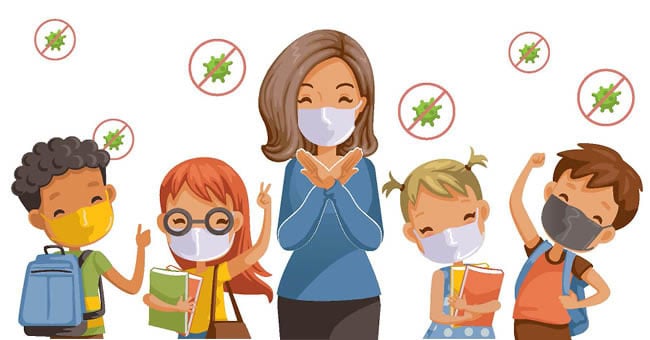
In this blog, Dr. Angela Searcy shares five tips for maintaining classroom connections and comfort without sacrificing social-emotional learning, all while keeping educators and the children they serve healthy and safe in accordance to CDC guidelines.
Given our new normal, it is understandable that childcare providers, educators, and camp counselors might feel anxious as they try to balance comfort and crisis management. You would be correct to assume that now more than ever it is critical to keep connections and comforting care at the forefront. As an educational consultant and child development specialist, here are five facts I've gathered that might help alleviate your worries.
1. CDC guidelines regulate health and hygiene more than hugs!
Since it is important for caregivers to be in close proximity to children in order to provide quality care, the Centers for Disease Control (CDC) guidelines acknowledge it is understandable that staff are close to children and provide comfort. Under the CDC's guidelines for infants and toddlers , a section that provides direction on holding a child states, "It is important to comfort crying, sad, and/or anxious infants and toddlers, and they often need to be held." The CDC does not advise caregivers to refrain from comforting children, instead, it suggests ways to meet the needs of children safely. The recommendations suggest strategies that protect providers such as wearing face coverings when feasible, clothing such as over large long sleeve shirts, pulling long hair up off the collar, and regularly washing hands, necks, and anywhere touched by a child's secretions. Yes, even the CDC is keenly aware of the intense number of tears and snot bubbles caregivers are exposed to when working with young children!
2. CDC suggestions support key components of quality and comforting caregiving.
As preschool programs and summer camps reconvene, the CDC guidelines suggest prioritizing and adding additional outside time, increasing behaviors like washing hands or disinfecting shared items, and lowering the risk of exposure with groups staying together for an entire day–all of which I would have encouraged before COVID-19. Staying with the same preschool teacher, caregiver, camp counselor or group of children can potentially help strengthen emotional connections with a consistent caregiver, reduce transitions, and increase continuity of care. Increasing hygiene habits, and physical activity are just the icing on top of a quality caregiving cake! While having one consistent caregiver can be challenging in terms of staffing, it can provide children with a consistent caregiving relationship and, instead of navigating relationships with large numbers of students, smaller groups might help children to develop friendships and hone friendship skills in smaller more intimate groups.
3. CDC mandates are manageable.
Raise your hand if you feel anxious that new mandates will inhibit your ability to comfort or meet the emotional needs of young children. You are not alone.
However, you might be relieved when you notice within the CDC guidelines, the mandates constantly use terms such as "when feasible," "encourage," "as much as possible," "support," and "consider." These words acknowledge that implementing all these new policies will be a process. It was a relief to read words like "adjust," "modify," or "intensify" in the guidelines. It was a good reminder that many of these suggestions are strategies many programs already have in place and already experts on implementing. Lastly, the CDC also encourages programs to collaborate with local health officials to determine a set of strategies that fit with YOUR community's circumstances.
4. The CDC recommends physical distancing, not emotional distancing.
Yes, the official term is "social distancing" but don't confuse that with emotional distancing. We can still talk to children, laugh with them, and comfort them. As an educator and child development specialist, labeling feelings, singing songs, dancing, and even giving out tickles are still on the table when it comes to comforting children. Children can comfort each other with a high five or smile. I have used baskets full of calming toys, fidget toys, playdough (children need their own personal container to limit the spread of COVID-19), bubbles, and pinwheels to comfort children. Calming spray, which is just a bottle of water and a couple of drops of vanilla extract, can help children relax as they spray sweet and calming smells into the air. Calming dances and quiet areas with relaxing books or pictures are also still key comforting components in any quality classroom settings during COVID-19.
5. A calm child can't exist without a calm adult!
In my book, Push Past It! A Positive Approach to Challenging Classroom Behaviors, I suggest a calm child can't exist without a calm adult. Children are co-regulators and, just like a tandem bicycle, you can't maneuver one component without influencing the others. As a result, children and even families will take cues on how to behave from leadership and staff. Be sure to share ideas instead of fear, be a good role model that implements your own appropriate calming strategies, and remember young children need repetition and practice before they can use calming strategies consistently and independently without adult support. Programs should also ensure they address stress and crisis management and that staff has access to mental health support during this emergency.
About the Author
Dr. Angela Searcy, has more than 25 years of experience in education, providing services to children and families as a teacher, child-development specialist, and independent consultant. A former neurodevelopment specialist, she is the owner and founder of Simple Solutions Educational Services, a professional-development company. She is a trainer, a speaker, and a seminar leader at the Erikson Institute in Chicago, Illinois.
